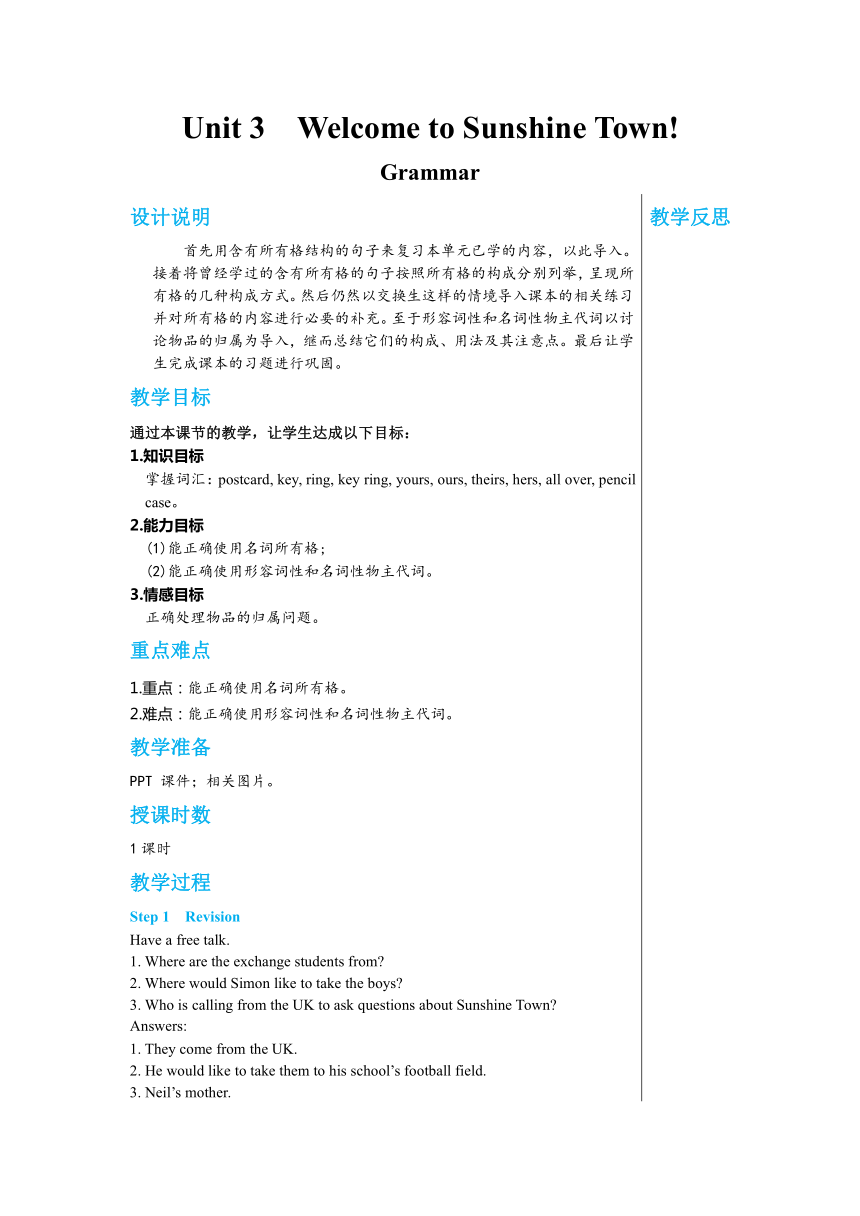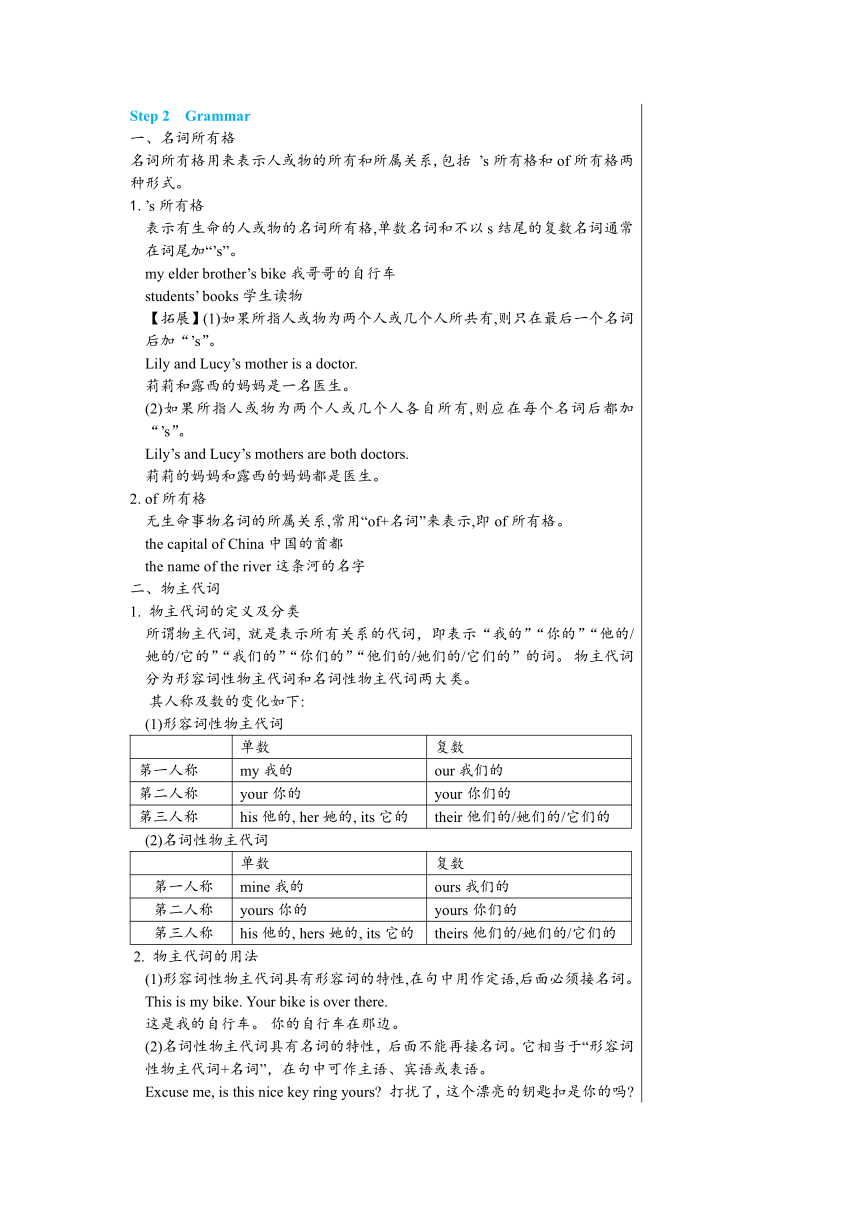Unit 3 Grammar教学详案-译林牛津版初中英语七年级(下)
文档属性
| 名称 | Unit 3 Grammar教学详案-译林牛津版初中英语七年级(下) |  | |
| 格式 | docx | ||
| 文件大小 | 29.3KB | ||
| 资源类型 | 试卷 | ||
| 版本资源 | 牛津译林版 | ||
| 科目 | 英语 | ||
| 更新时间 | 2024-02-21 19:45:06 | ||
图片预览


文档简介
Unit 3 Welcome to Sunshine Town!
Grammar
设计说明 首先用含有所有格结构的句子来复习本单元已学的内容,以此导入。接着将曾经学过的含有所有格的句子按照所有格的构成分别列举,呈现所有格的几种构成方式。然后仍然以交换生这样的情境导入课本的相关练习并对所有格的内容进行必要的补充。至于形容词性和名词性物主代词以讨论物品的归属为导入,继而总结它们的构成、用法及其注意点。最后让学生完成课本的习题进行巩固。 教学目标 通过本课节的教学,让学生达成以下目标: 1.知识目标 掌握词汇:postcard, key, ring, key ring, yours, ours, theirs, hers, all over, pencil case。 2.能力目标 (1)能正确使用名词所有格; (2)能正确使用形容词性和名词性物主代词。 3.情感目标 正确处理物品的归属问题。 重点难点 1.重点:能正确使用名词所有格。 2.难点:能正确使用形容词性和名词性物主代词。 教学准备 PPT 课件;相关图片。 授课时数 1课时 教学过程 Step 1 Revision Have a free talk. 1. Where are the exchange students from 2. Where would Simon like to take the boys 3. Who is calling from the UK to ask questions about Sunshine Town Answers: 1. They come from the UK. 2. He would like to take them to his school’s football field. 3. Neil’s mother. Step 2 Grammar 一、名词所有格 名词所有格用来表示人或物的所有和所属关系,包括 ’s所有格和of所有格两种形式。 1.’s所有格 表示有生命的人或物的名词所有格,单数名词和不以s结尾的复数名词通常在词尾加“’s”。 my elder brother’s bike 我哥哥的自行车 students’ books 学生读物 【拓展】(1)如果所指人或物为两个人或几个人所共有,则只在最后一个名词后加“’s”。 Lily and Lucy’s mother is a doctor. 莉莉和露西的妈妈是一名医生。 (2)如果所指人或物为两个人或几个人各自所有,则应在每个名词后都加“’s”。 Lily’s and Lucy’s mothers are both doctors. 莉莉的妈妈和露西的妈妈都是医生。 2. of所有格 无生命事物名词的所属关系,常用“of+名词”来表示,即of所有格。 the capital of China 中国的首都 the name of the river这条河的名字 二、物主代词 1. 物主代词的定义及分类 所谓物主代词, 就是表示所有关系的代词,即表示“我的”“你的”“他的/她的/它的”“我们的”“你们的”“他们的/她们的/它们的”的词。 物主代词分为形容词性物主代词和名词性物主代词两大类。 其人称及数的变化如下: (1)形容词性物主代词 单数复数第一人称my我的our我们的第二人称your 你的your你们的第三人称his他的, her她的, its它的their他们的/她们的/它们的
(2)名词性物主代词 单数复数第一人称mine我的ours我们的第二人称yours 你的yours你们的第三人称his他的, hers她的, its它的theirs他们的/她们的/它们的
2. 物主代词的用法 (1)形容词性物主代词具有形容词的特性,在句中用作定语,后面必须接名词。 This is my bike. Your bike is over there. 这是我的自行车。 你的自行车在那边。 (2)名词性物主代词具有名词的特性,后面不能再接名词。它相当于“形容词性物主代词+名词”,在句中可作主语、宾语或表语。 Excuse me, is this nice key ring yours 打扰了,这个漂亮的钥匙扣是你的吗 (3)“of+名词性物主代词”可以作名词的后置定语。 The girl is a friend of his.那个女孩是他的一个朋友。 Step 3 Presentation A. Present some sentences including the idea of belonging. 1. Are you my master 2. Millie’s classmate David is writing about his favourite sport. 3. The parents’ meeting begins at two o’clock in the afternoon. 4. Millie seldom chats with her friends after class. 5. What is your favourite festival, Tommy 6. We can use nouns before uncountable nouns to show their amounts. 7. The hair clips match Sandy’s skirt. 8. My parents and I are planning a day out with my uncle's family. 9. An old friend of mine is coming to see me. Hobo. 10. I’d like to take the boys to our school’s football field. 11. There are lots of nice shops in our town. B. Divide the sentences into different groups. 1. singular noun +’s 2. plural noun + ’s/’(ending in -s+’, not ending in -s +’s) 3. names +’s Step 4 Practice 1. Present the exercises on Page 35. Answers: (1) Whose postcards are these They’re Millie’s. (2) Whose cap is this It’s Daniel’s. (3) Whose T-shirt is that It’s Kitty’s. (4) Whose key ring is that It’s Daniel’s. (5) Whose pencils are those They’re Millie’s. 2. Add more exercises to present more important points about the idea of belonging. (1) Fill in the blanks according to the given words. ①The online shop sells shoes at a very low price. (woman) ②We usually have a seven holiday every National Day. (day) 表示时间、距离、国家、城市的名词,单数名词加’s或复数名词加’s/’构成所有格。 ③If you are a good boy at the office, I’ll take you to the zoo after that. (doctor) (2)Translate the sentences. ④请放学后在教室门口等我。 (of, 常用于无生命事物) ⑤后天我父亲的一个老朋友要来看他。(of + ’s, 双重所有格) ⑥Mrs. King 是Lucy 和 Lily的母亲。(两人共有某物,用A and B’s ) ⑦这分别是Lucy和Lily的床。 (两人分别拥有某物,用A’s and B’s) Answers: ①The online shop sells women’s shoes at a very low price.(woman) ②We usually have a seven days’ holiday every National Day.(day) ③If you are a good boy at the doctor’s office, I’ll take you to the zoo after that.(doctor) ④ 请放学后在教室门口等我。 Please wait for me at the door of the classroom after class. ⑤后天我父亲的一个老朋友要来看他。 An old friend of my father’s is coming to see him the day after tomorrow. ⑥Mrs. King 是Lucy和Lily的母亲。 Mrs. King is Lucy and Lily’s mother. ⑦这分别是Lucy和Lily的床。 These are Lucy’s and Lily’s beds. Step 5 Presentation 1. Point to some objects and ask “Whose is this ”. This is Mike’s cup. This is his cup. This cup is his. This is my sister’s poster. This is her poster. This poster is hers. This is the twins’ chocolate. This is their chocolate. This chocolate is theirs. 2. Present the forms of possessive adjectives and pronouns. 3. Present some special points: 形容词性物主代词在句中可以做定语,后面必须接名词;名词性物主代词后 不能再接名词,以免重复。名词性物主代词在句中单独使用,可以做表语、主语、宾语等。作主语时,谓语动词的单复数与它所指代的名词有关。 its 它的(东西) it’s =it is 它是 4. Ask the students to finish the exercises on Page 36. Answers: Daniel: Look at(1)our books. They’re all over the place. Millie: Are those(2)your books, Amy Amy: No, they aren’t (3)mine. They’re Sandy’s. (4)My book is under Sandy’s chair. Sandy: Yes. And(5)yours is here too, Simon. Simon: What about that book, Sandy Is it(6)yours Sandy: No. It’s Millie’s. Daniel: Oh yes, it’s(7)hers , and here is(8)my book. It’s next to Amy’s pencil case. Step 6 Homework 1. Review the Grammar by heart. 2. Do some exercises after class. 当堂达标 Ⅰ. 根据句意用所给单词的适当形式填空 1. They are not my books. They are (he). 2. Please give this to Susan. It is ( she) pen. 3. We are working hard on (we) project. 4. My flat is on the third floor. (they) is on the tenth floor. 5. I can’t find my ruler . Can I borrow ( you) 6. This is (I) comic book. (you) is over there. 7. —Whose car is that —It’s _______ (I). 8. (we) team will win the game. 9.Mrs Wang is (he) English teacher. 10.The cat is (she). (it) hair is white. Ⅱ. 将下面句子改为同义句 1. This is her bike and that is his bike, This bike is and that one is . 2. Simon is one of their old friends. Simon is an old friend of . 3. My dog is black and white. It has two long ears. My dog is black and white. ears are long. 4. Lily and Lucy share a bedroom. The bedroom is . 5. I have a long coat and you have a short coat. coat is long and is short. Answers: Ⅰ. 1.his 2.her 3.our 4. Theirs 5. yours 6. my;Yours 7. mine 8.Our 9.his 10. hers;Its Ⅱ. 1. hers, his 2. theirs 3. Its 4. Lily and Lucy’s 5. My, yours 板书设计 Unit 3 Welcome to Sunshine Town! Grammarpostcard,key,ring,yours,ours,theirs,hers,all over, pencil caseNoun +’s possessive adjectives and pronouns
教学反思
Grammar
设计说明 首先用含有所有格结构的句子来复习本单元已学的内容,以此导入。接着将曾经学过的含有所有格的句子按照所有格的构成分别列举,呈现所有格的几种构成方式。然后仍然以交换生这样的情境导入课本的相关练习并对所有格的内容进行必要的补充。至于形容词性和名词性物主代词以讨论物品的归属为导入,继而总结它们的构成、用法及其注意点。最后让学生完成课本的习题进行巩固。 教学目标 通过本课节的教学,让学生达成以下目标: 1.知识目标 掌握词汇:postcard, key, ring, key ring, yours, ours, theirs, hers, all over, pencil case。 2.能力目标 (1)能正确使用名词所有格; (2)能正确使用形容词性和名词性物主代词。 3.情感目标 正确处理物品的归属问题。 重点难点 1.重点:能正确使用名词所有格。 2.难点:能正确使用形容词性和名词性物主代词。 教学准备 PPT 课件;相关图片。 授课时数 1课时 教学过程 Step 1 Revision Have a free talk. 1. Where are the exchange students from 2. Where would Simon like to take the boys 3. Who is calling from the UK to ask questions about Sunshine Town Answers: 1. They come from the UK. 2. He would like to take them to his school’s football field. 3. Neil’s mother. Step 2 Grammar 一、名词所有格 名词所有格用来表示人或物的所有和所属关系,包括 ’s所有格和of所有格两种形式。 1.’s所有格 表示有生命的人或物的名词所有格,单数名词和不以s结尾的复数名词通常在词尾加“’s”。 my elder brother’s bike 我哥哥的自行车 students’ books 学生读物 【拓展】(1)如果所指人或物为两个人或几个人所共有,则只在最后一个名词后加“’s”。 Lily and Lucy’s mother is a doctor. 莉莉和露西的妈妈是一名医生。 (2)如果所指人或物为两个人或几个人各自所有,则应在每个名词后都加“’s”。 Lily’s and Lucy’s mothers are both doctors. 莉莉的妈妈和露西的妈妈都是医生。 2. of所有格 无生命事物名词的所属关系,常用“of+名词”来表示,即of所有格。 the capital of China 中国的首都 the name of the river这条河的名字 二、物主代词 1. 物主代词的定义及分类 所谓物主代词, 就是表示所有关系的代词,即表示“我的”“你的”“他的/她的/它的”“我们的”“你们的”“他们的/她们的/它们的”的词。 物主代词分为形容词性物主代词和名词性物主代词两大类。 其人称及数的变化如下: (1)形容词性物主代词 单数复数第一人称my我的our我们的第二人称your 你的your你们的第三人称his他的, her她的, its它的their他们的/她们的/它们的
(2)名词性物主代词 单数复数第一人称mine我的ours我们的第二人称yours 你的yours你们的第三人称his他的, hers她的, its它的theirs他们的/她们的/它们的
2. 物主代词的用法 (1)形容词性物主代词具有形容词的特性,在句中用作定语,后面必须接名词。 This is my bike. Your bike is over there. 这是我的自行车。 你的自行车在那边。 (2)名词性物主代词具有名词的特性,后面不能再接名词。它相当于“形容词性物主代词+名词”,在句中可作主语、宾语或表语。 Excuse me, is this nice key ring yours 打扰了,这个漂亮的钥匙扣是你的吗 (3)“of+名词性物主代词”可以作名词的后置定语。 The girl is a friend of his.那个女孩是他的一个朋友。 Step 3 Presentation A. Present some sentences including the idea of belonging. 1. Are you my master 2. Millie’s classmate David is writing about his favourite sport. 3. The parents’ meeting begins at two o’clock in the afternoon. 4. Millie seldom chats with her friends after class. 5. What is your favourite festival, Tommy 6. We can use nouns before uncountable nouns to show their amounts. 7. The hair clips match Sandy’s skirt. 8. My parents and I are planning a day out with my uncle's family. 9. An old friend of mine is coming to see me. Hobo. 10. I’d like to take the boys to our school’s football field. 11. There are lots of nice shops in our town. B. Divide the sentences into different groups. 1. singular noun +’s 2. plural noun + ’s/’(ending in -s+’, not ending in -s +’s) 3. names +’s Step 4 Practice 1. Present the exercises on Page 35. Answers: (1) Whose postcards are these They’re Millie’s. (2) Whose cap is this It’s Daniel’s. (3) Whose T-shirt is that It’s Kitty’s. (4) Whose key ring is that It’s Daniel’s. (5) Whose pencils are those They’re Millie’s. 2. Add more exercises to present more important points about the idea of belonging. (1) Fill in the blanks according to the given words. ①The online shop sells shoes at a very low price. (woman) ②We usually have a seven holiday every National Day. (day) 表示时间、距离、国家、城市的名词,单数名词加’s或复数名词加’s/’构成所有格。 ③If you are a good boy at the office, I’ll take you to the zoo after that. (doctor) (2)Translate the sentences. ④请放学后在教室门口等我。 (of, 常用于无生命事物) ⑤后天我父亲的一个老朋友要来看他。(of + ’s, 双重所有格) ⑥Mrs. King 是Lucy 和 Lily的母亲。(两人共有某物,用A and B’s ) ⑦这分别是Lucy和Lily的床。 (两人分别拥有某物,用A’s and B’s) Answers: ①The online shop sells women’s shoes at a very low price.(woman) ②We usually have a seven days’ holiday every National Day.(day) ③If you are a good boy at the doctor’s office, I’ll take you to the zoo after that.(doctor) ④ 请放学后在教室门口等我。 Please wait for me at the door of the classroom after class. ⑤后天我父亲的一个老朋友要来看他。 An old friend of my father’s is coming to see him the day after tomorrow. ⑥Mrs. King 是Lucy和Lily的母亲。 Mrs. King is Lucy and Lily’s mother. ⑦这分别是Lucy和Lily的床。 These are Lucy’s and Lily’s beds. Step 5 Presentation 1. Point to some objects and ask “Whose is this ”. This is Mike’s cup. This is his cup. This cup is his. This is my sister’s poster. This is her poster. This poster is hers. This is the twins’ chocolate. This is their chocolate. This chocolate is theirs. 2. Present the forms of possessive adjectives and pronouns. 3. Present some special points: 形容词性物主代词在句中可以做定语,后面必须接名词;名词性物主代词后 不能再接名词,以免重复。名词性物主代词在句中单独使用,可以做表语、主语、宾语等。作主语时,谓语动词的单复数与它所指代的名词有关。 its 它的(东西) it’s =it is 它是 4. Ask the students to finish the exercises on Page 36. Answers: Daniel: Look at(1)our books. They’re all over the place. Millie: Are those(2)your books, Amy Amy: No, they aren’t (3)mine. They’re Sandy’s. (4)My book is under Sandy’s chair. Sandy: Yes. And(5)yours is here too, Simon. Simon: What about that book, Sandy Is it(6)yours Sandy: No. It’s Millie’s. Daniel: Oh yes, it’s(7)hers , and here is(8)my book. It’s next to Amy’s pencil case. Step 6 Homework 1. Review the Grammar by heart. 2. Do some exercises after class. 当堂达标 Ⅰ. 根据句意用所给单词的适当形式填空 1. They are not my books. They are (he). 2. Please give this to Susan. It is ( she) pen. 3. We are working hard on (we) project. 4. My flat is on the third floor. (they) is on the tenth floor. 5. I can’t find my ruler . Can I borrow ( you) 6. This is (I) comic book. (you) is over there. 7. —Whose car is that —It’s _______ (I). 8. (we) team will win the game. 9.Mrs Wang is (he) English teacher. 10.The cat is (she). (it) hair is white. Ⅱ. 将下面句子改为同义句 1. This is her bike and that is his bike, This bike is and that one is . 2. Simon is one of their old friends. Simon is an old friend of . 3. My dog is black and white. It has two long ears. My dog is black and white. ears are long. 4. Lily and Lucy share a bedroom. The bedroom is . 5. I have a long coat and you have a short coat. coat is long and is short. Answers: Ⅰ. 1.his 2.her 3.our 4. Theirs 5. yours 6. my;Yours 7. mine 8.Our 9.his 10. hers;Its Ⅱ. 1. hers, his 2. theirs 3. Its 4. Lily and Lucy’s 5. My, yours 板书设计 Unit 3 Welcome to Sunshine Town! Grammarpostcard,key,ring,yours,ours,theirs,hers,all over, pencil caseNoun +’s possessive adjectives and pronouns
教学反思
